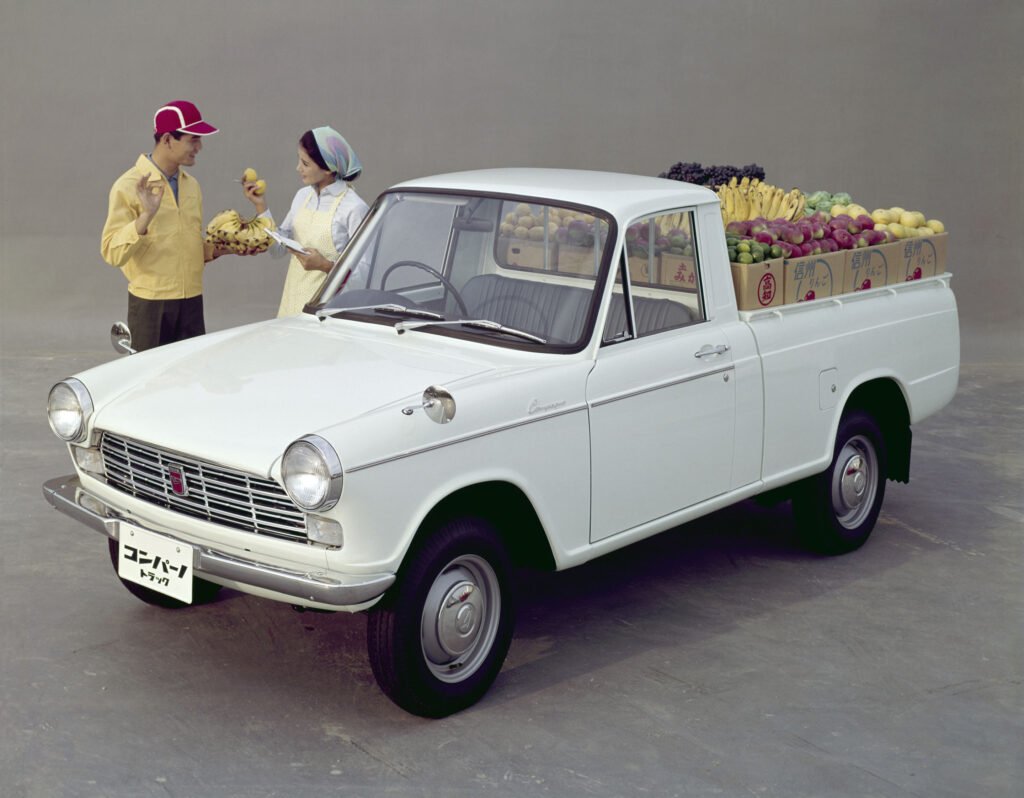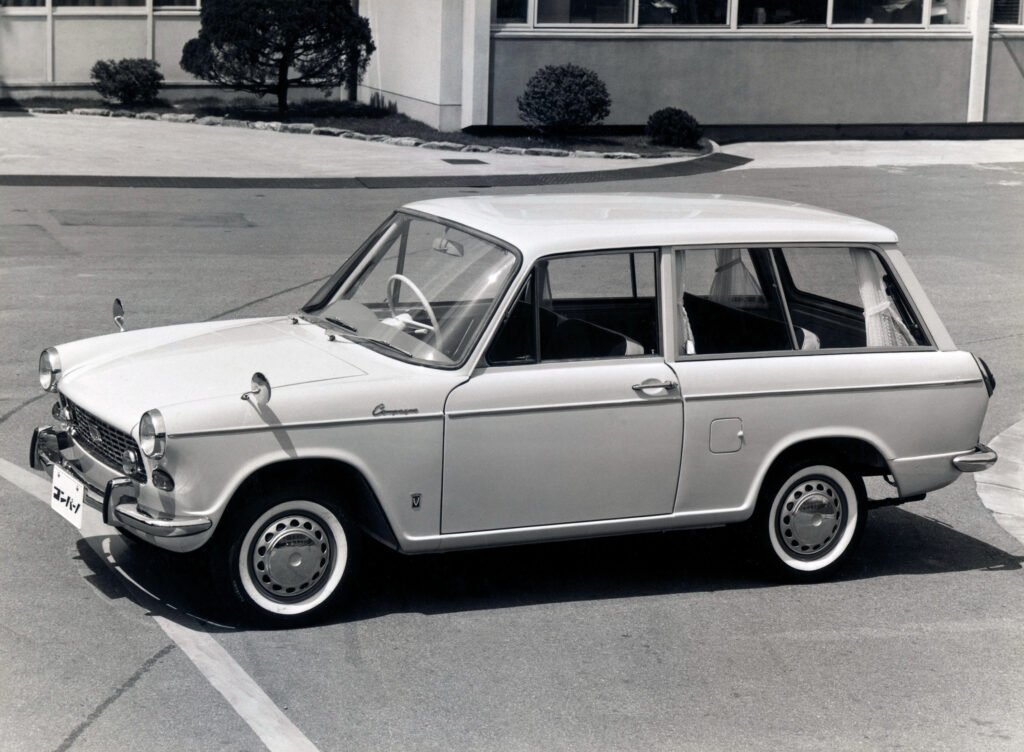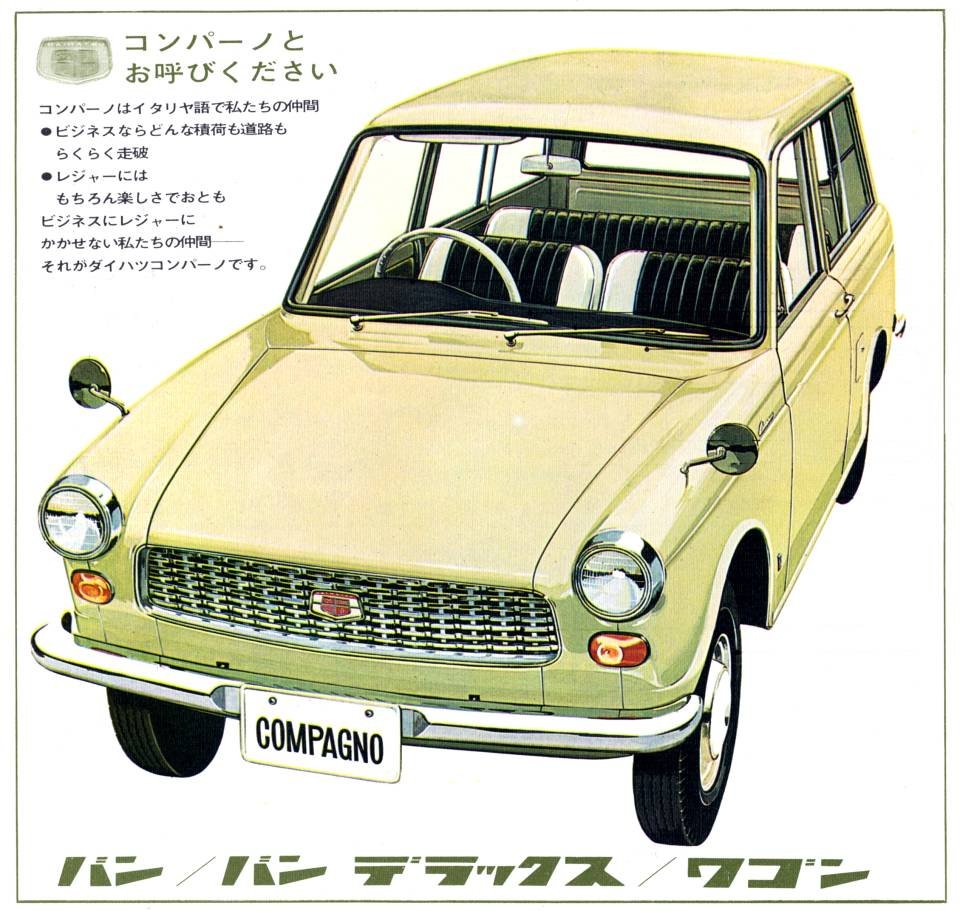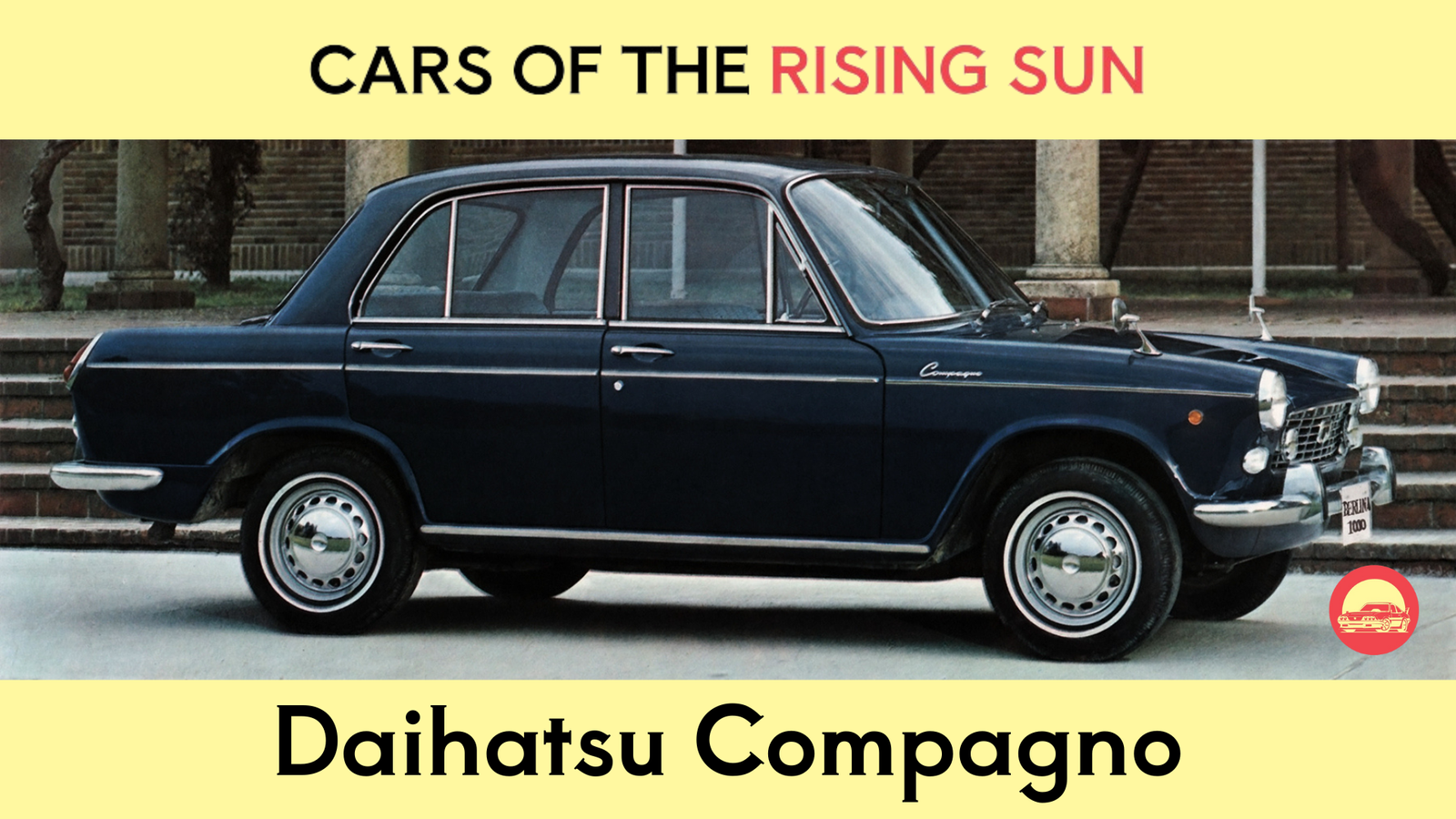Around 120,000 Daihatsu Compagno were produced between 1963 and 1970.
For the 800 models, the maximum speed was around 70 mph (110 km/h). For the 1000 and Spider, between 80 to 90 mph (130 to 145 km/h).
Hello! For the blog’s first post, I would like to introduce you to one of my favorite Japanese cars of the ’60s, the Daihatsu Compagno. When I first saw this car when looking at the Daihatsu page on Wikipedia, I didn’t give much to it. Still, when I read a couple of articles and saw the evolution that this car went through and its importance to Daihatsu, I found it very amazing.
The Daihatsu Compagno is a classic car, and also the first four-wheel car made by the Daihatsu company. It was launched in April of 1963 in a van-style body, later followed by other body types such as a sedan, pick-up truck, and a curious convertible.
The name “Compagno” means fellow, buddy, mate, companion, or partner in Italian.
History

Before we discuss the model itself, we need to talk about the context in which the company was inserted at the time. Before 1963, Daihatsu had been producing three-wheelers since the ’50s and the company had a good position on the market, competing with the now-called Mazda for the first place in sales and production of three-wheelers.
It’s important to know that in the post-war era, four-wheel cars were not common in Japan because the country was still recovering from the war, but in the ’60s, the four-wheel market was expected to grow. This prediction motivated the government to incentivize the automakers to start developing and producing small passenger cars.
The Compagno was the first Japanese car officially imported to the United Kingdom, in 1965. This fact marks the beginning of the long-running commercial trade of cars from Japan to the UK.
Design

The design was made by Vignale, an Italian company that had also participated in the design of some famous European cars such as the Alfa Romeo 2000, Ferrari 250, and Ferrari 166. The Daihatsu Compagno is the only Japanese car that Vignale ever designed.
The body design is similar to what was used in other cars of the early ’60s in Japan: a small European-looking body, few details on the side, lots of metallic accessories and frames, rounded lights, and simple grids. Not too many details, as you can expect for the first modern cars of post-war Japan.
Throughout its production, the car was available as a sedan, van, convertible, and pick-up truck. All bodies were built in a ladder-frame chassis and the dimensions were 87.4 in (2,220 mm) for the wheelbase, 149.6 in (3,800 mm) length, 56.1 in (1,425 mm) width, 56.3 in (1,430 mm) height and 1,687 lbs (765 kg) of curb weight. The 4-door sedan and pick-up truck had a wheelbase of 89,8 in (2,280 mm).
It was produced as a FR (front-engine, rear-wheel-drive) layout with a double wishbone at the front and a rigid leaf rear suspension (a common combination of suspension for the time, but the double wishbone wasn’t used in a lot of cars in the same size category of the Compagno).
Powertrain
The Compagno was a long-running model compared to the other Japanese cars of the same size at the time. From 1963 to 1970, the car was powered by only two engines, the 0.8 liter FC and the 1.0 liter FE. All engines were under the 1,000 cc limit (this was the maximum limit for the lower tax class in Japan).
Daihatsu’s FC Engine
The first engine that powered the Compagno was the Daihatsu’s 797 cc FC. It was an inline-four OHV engine that delivered between 39 – 41 horsepower and 63.7 N.m. torque, depending on the trim and time.
The engine had a bore x stroke dimension of about 2.44 in x 2.60 in (62.0 mm x 66.0 mm) and was also used by the company’s New Line. The fuel consumption was 54 mpg (23 km/l) and the engine was somewhat lightweight, mostly because of the aluminum alloy cylinder head.
Daihatsu’s FE Engine
The FE Engine was also an inline-four OHV but, along with the Compagno model, it was used in a variety of tunings. The bore x stroke was about 2.67 in x 2.60 in (68.0 mm x 66.0 mm).
A single carburetor version of the FE was used on the Compagno, its successor Consorte, and the Taft. The power delivered was about 55 horsepower and 77 N.m. torque, with a compression of 7.8:11.
A twin-carb FE powered the Spider (convertible) and the 1000GT, the sporty trims of the Compagno. It delivered about 65 horsepower (this was a considerable amount for a car this size at the time) and 76.5 N.m. torque.
Finally, Daihatsu went ambitious, releasing the Compagno 1000GT Injection trim. Fuel injection wasn’t common at the time, and although the power was the same as the twin-carb, the Compagno 1000GT was the first production car in Japan equipped with a fuel injection engine.
Trims and Variations
Compagno 800 and 1000

The main trims of the Compagno were the 800 and the 1000. The 800 was equipped with the FC engine and the 1000 with the FE. The price at the time was about JPY 578,000.
The grades were “Standard” and “Deluxe” at the beginning and the “Super Deluxe” between 1967 and the end of its production. The Deluxe was equipped with a wood-like steering wheel and instrument panel, a radio, and a heater as standard.
In 1965, a four-door sedan was added. In the same year, the pick-up truck was also added to the line, it was the successor of the New Line and had a cargo capacity of 1102 lbs (500 kg) and was powered by the 1,000 liter FE. In 1967, the four-door Super Deluxe was launched and it was the highest grade Compagno.
Since the start of production, a manual four-speed transmission was used and in 1967 a two-speed automatic transmission became available.
Compagno 1000GT and Spider

In 1965 the Compagno Spider was released, equipped with the twin-carb FE engine that delivered 65 horsepower. A prototype of the Spider was exhibited at the Tokyo Motor Show a year before and was claimed to be a four-seater convertible car that suits a family (the sedan was a five-seater).
Late the same year, the 1000GT became available, powered by the same engine variation and added to the 2-door sedan trims. In 1967, along with the facelift that the entire line received, the 1000GT Injection became available and the 1000GT, 1000 GT Injection, and Spider trims received front disc brakes.
The Daihatsu Compagno Amongst The Competitors

It’s hard to classify ’60s and ’70s Japanese cars, the country itself didn’t have a much descriptive types of vehicle classes and segments. Usually when I’m comparing this era vehicles, I try to compare by different characteristics such as size, powertrain, and price (if possible).
The Toyota Publica was the main competitor of the Compagno, but the differences between both are curious. The Compagno is larger, about a size class above the Publica, but the Publica is heavier because of its monocoque chassis. Both cars had a top speed of about 70 mph (110 km/h) and the same suspension type. A curious fact is that the Daihatsu Consorte, the Compagno’s successor, was based on the Toyota Publica because of the Daihatsu-Toyota business alliance in 1967.
Other models that can be named competitors to the Compagno, although being of different sizes, are the first generations of the Mazda Familia (1963 – 1968), the Nissan Sunny (1966 – 1970), and the low-litter model of the Toyota Corolla (1966 – 1970).
Final Lap
In conclusion, the Daihatsu Compagno is an incredible piece of history. I think that this car represents a new shift in the market, technology, and design that Japan would go through in the following decades.
About 120,000 were produced between 1963 and 1970. Its successor was the Consorte (I will write about it in the future).





Well, this is it. Of course, there is a lot more to talk about the Compagno, and feel free to leave a comment if you want to know more about the car or if you want to add something that I missed on this post!
Have a nice day!


